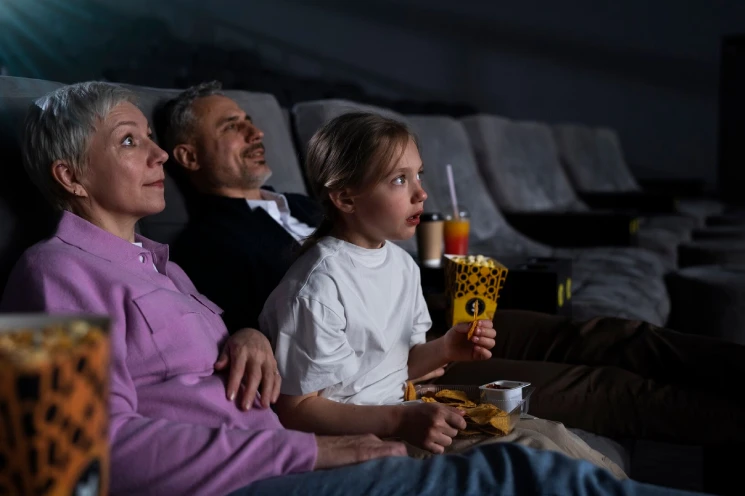Cinematic Consumers: A Study of Movie Audience Demographics

Movies have this incredible power to unite us, but have you ever wondered who's sitting next to you in the theater or watching alongside you at home?
Studies show that our movie preferences are as diverse as the stories on the big screen.
They're influenced by various factors, from age groups and income brackets to where we live and our educational backgrounds.
It's fascinating how these aspects shape the films we choose to watch.
- Movie preferences reflect diverse demographics, from age to income and cultural backgrounds.
- Age shapes tastes: youth seek action, middle-aged explore variety, and elders prefer reflection.
- Gender stereotypes in film preferences shift as men and women embrace diverse genres.
- Income influences movie consumption: higher earnings correlate with increased theater visits.
- Streaming services democratize access, altering demographics and impacting traditional movie-watching habits.
Overview of Movie Audience Demographics
Movie preferences aren't just about liking action over romance; they're a complex interplay of who we are. Let's break it down:
By Age

Age isn’t just a number when it comes to movie preferences; it’s a defining factor that shapes our cinematic tastes. Studies consistently highlight distinct trends across various age brackets.
The young people of the 18-24 age group often translate into a love for adrenaline-pumping action films, sci-fi adventures, and fantasy epics.
During a survey by Statista, half of the respondents aged 18-34 (the average age) said they went to the movies often or sometimes.
They seek thrill, special effects, and larger-than-life narratives that resonate with their energy and curiosity.
Blockbusters like the Marvel Cinematic Universe or epic franchises like "Harry Potter" tend to magnetize this demographic.
The 25-39 age cohort exhibits a broader spectrum of preferences, leaning toward a mix of action, comedy, drama, and romantic genres.
Among respondents from the 35-44 age group in the same survey, 45 percent said they went to the movies often or sometimes, showcasing a slightly lower but still significant engagement with theaters.
This group navigates between family-friendly animations and more mature narratives.
Those aged 40 and above or older adults often gravitate toward thought-provoking dramas, nostalgic throwbacks, and heartwarming comedies.
However, the survey noted that three out of 10 interviewees aged 65 and over said they never went to see a film in theaters, reflecting a lesser inclination toward cinema visits within this demographic.
By Gender
Historically drawn to action-packed movies and thrillers, male audiences have been captivated by high-speed chases, epic battles, and explosive sequences.
According to Statista, almost half (46 percent) of male adults surveyed online in the United States said they are regular cinemagoers.
However, recent surveys (as of late December 2023) indicate a shift. Genres like drama and romantic comedies are gaining traction among male viewers, indicating a broader range of interests beyond traditional action-centric preferences.
Traditionally, rom-coms, dramas, and romantic fantasies have been favorites among female viewers.
The emotional depth, intricate relationships, and character-driven narratives often resonate strongly.
However, the combined share of women who went to the movies often or sometimes stood at 37 percent, indicating a somewhat lower engagement than male counterparts.
Interestingly, women are increasingly exploring action-packed blockbusters and diverse genres, showcasing a widening spectrum of interests.
Changing Dynamics: There's a noticeable convergence in genre preferences between genders. Both men and women are diversifying their movie tastes, challenging stereotypes, and embracing a broader cinematic experience.
By Income and Socioeconomic Status

Those in higher-income brackets often exhibit a higher frequency of visits to movie theaters.
According to a survey conducted in the United States, little more than one-third (36 percent) of responding internet users whose household income stood below 50 thousand U.S. dollars said they went to the movies either often or sometimes.
In contrast, among respondents whose income surpassed 100 thousand dollars, the combined share stood at 53 percent. This disparity indicates a noticeable difference in cinema-going habits based on income levels.
Financial constraints might limit the frequency of theatrical outings for lower-income groups, leading to a preference for more affordable entertainment options such as streaming services.
This demographic often seeks cost-effective alternatives to access a diverse range of movies.
With the rise of streaming platforms, socioeconomic status has become less of a barrier to accessing a diverse range of movies.
Lower-income households can now enjoy a vast library of films at a fraction of the cost of a theater ticket, contributing to the changing landscape of movie consumption.
By Race
Cultural backgrounds significantly shape movie preferences and contribute to diverse viewing habits across different racial demographics.
- White Audiences: White audiences historically form a significant portion of moviegoers, representing the largest share of tickets sold. In 2017, they constituted 55% of tickets sold, which equated to approximately 682 million tickets. Their preferences often encompass a wide range of genres and narratives.
- Hispanic Audiences: Hispanic moviegoers represented 23% of tickets sold, making up approximately 285 million tickets. This demographic has shown a strong inclination toward films that reflect their cultural experiences and identities.
- Black Audiences: Representing 12% of movie attendance, black movie audiences accounted for approximately 149 million tickets. This demographic often seeks representation and resonates with movies that reflect their stories and experiences.
- Asian Audiences: Asian moviegoers made up 7% of tickets sold, amounting to approximately 86.8 million tickets. This group often embraces films that showcase diverse cultural perspectives and narratives.
By Location
Geographical location plays a significant role in shaping movie preferences and consumption habits, with distinct trends observed between urban and rural areas.
Urban locations often exhibit a more diverse range of movie preferences due to the availability of multiple theaters and a broader cultural mix.
Moviegoers in these areas have access to a variety of genres and often engage in frequent local cinema visits.
The diverse population in cities contributes to a wider range of cinematic tastes, encompassing everything from blockbusters to indie films.
In contrast, rural areas might showcase a preference for more traditional or family-oriented films.
The accessibility and availability of theaters might be more limited, influencing the types of movies shown and the frequency of visits. Family-centric or mainstream films often cater to the preferences of these communities.
By Education Level
Individuals with higher education often exhibit a broader range of movie interests, embracing various genres and narratives.
Their exposure to diverse ideas and critical thinking often leads to a more eclectic taste in films. They might enjoy everything from thought-provoking dramas to avant-garde indie productions.
On the other hand, those with lower education levels might prefer simpler, more straightforward narratives.
Their movie preferences might lean towards easily accessible and mainstream content, focusing on entertainment value rather than complex storytelling or themes.
By Family Status
Those with children often gravitate towards animated movies, family-friendly adventures, and films suitable for all ages.
The emphasis is on entertainment suitable for the entire family, leading to preferences for movies that cater to diverse age groups.
Animated features and franchises with wholesome, engaging storytelling often find favor among these movie audiences.
Individuals or couples without children might explore a broader spectrum of genres and themes.
Their movie choices are more diverse without considering family-friendly content, ranging from romantic comedies to intense thrillers or thought-provoking dramas.
They have the freedom to explore a wider range of cinematic experiences without catering to family-oriented preferences.
Technology and Changing Demographics
Technological advancements, particularly the rise of streaming services and digital platforms, have significantly impacted movie consumption habits and demographics.
The proliferation of streaming platforms has revolutionized how audiences access and consume movies.
These services offer a vast library of films, making diverse content easily accessible at any time.
This accessibility has democratized movie watching, appealing to a wide range of demographics, including those who might not frequently visit theaters.
The convenience of streaming services has altered the traditional demographic profiles of frequent moviegoers.
Streaming platforms have contributed to a demographic shift, attracting viewers across different age groups, income brackets, and geographic locations.
Younger audiences, in particular, are drawn to the flexibility and variety offered by these services, impacting their movie preferences and consumption habits.
Additionally, older demographics, who might have been less inclined to visit theaters, now have access to a plethora of films from the comfort of their homes.
The rise of digital platforms has led to reevaluating traditional marketing strategies and distribution methods within the movie industry.
Studios now tailor their releases to cater to both theatrical and digital audiences, acknowledging the changing landscape of movie consumption.
Marketing Strategies and Film Audience Demographics
Understanding audience demographics is integral to effective marketing strategies within the film industry.
Tailoring movie marketing campaigns to specific demographic groups ensures better engagement and resonance with target audiences.
- Targeted Advertising: Studios employ targeted advertising techniques to reach specific demographic segments. By analyzing data on age, gender, location, and preferences, they craft advertising campaigns that resonate with these groups. For instance, ads for family-oriented movies might target areas with higher concentrations of families or parents.
- Segmented Campaigns: Segmentation allows for the creation of diverse marketing campaigns. For instance, a film targeting younger audiences might focus on social media platforms, leveraging influencers and interactive content, while a movie appealing to older demographics might rely on traditional media channels such as television and print.
- Diversity in Representation: Recognizing the importance of diverse representation, studios incorporate inclusivity in marketing campaigns. Embracing diverse casts and storylines not only appeals to specific demographic groups but also fosters a sense of inclusivity and relevance among audiences.
- Analyzing Response Data: Utilizing data analytics, studios track audience responses to marketing efforts. Analyzing engagement metrics helps refine strategies, enabling adjustments based on audience behaviors and preferences.
Effectively aligning movie marketing strategies with potential audience demographics maximizes the impact of promotional efforts, leading to increased audience engagement and higher box office performance.
Conclusion
The study of movie audience demographics shows how important it is for filmmakers to understand the diversity of viewers' preferences and backgrounds.
By recognizing the interplay between age, gender, income, race, location, education, and family dynamics, filmmakers can better tailor their creations to resonate with a wider audience.
This better understanding shapes marketing strategies and influences the storytelling, themes, and representation within films.


